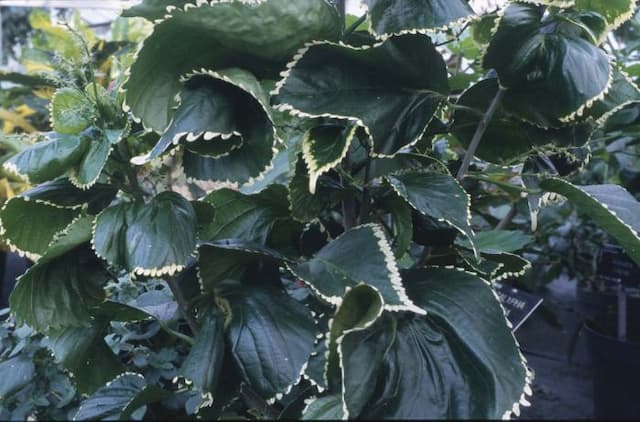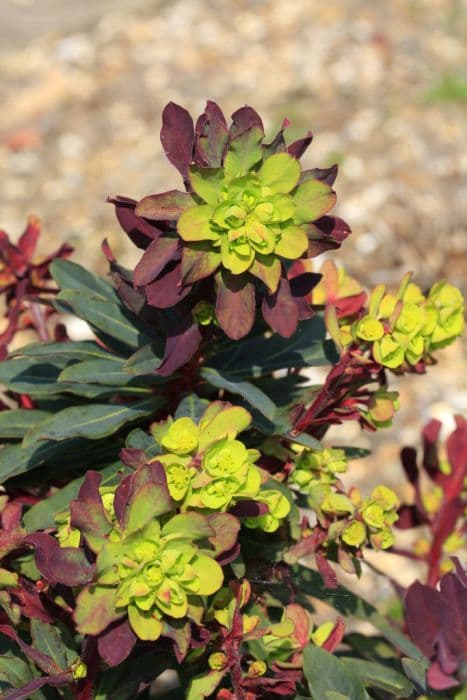Crown of Thorns Euphorbia donii 'Amjillasa'

ABOUT
The Euphoria 'Amjillasa' is a visually striking plant with a unique appearance. It is characterized by its vivid green foliage which may take on a compact and bushy form. The leaves are typically oblong in shape and have a smooth, glossy surface that can catch the light, giving them an almost shimmering quality. The foliage might show a range of green shades, from deep forest greens to lighter, almost yellow-green hues. As for the flowers, they are inconspicuous and often go unnoticed, as is common with many members of the Euphorbia family. Instead, the plant is known for its ornamental foliage. If present, the flowers will be small, and their color can vary from yellows to reds or greens. They do not usually have petals like traditional flowers, but rather consist of a specialized structure that includes a cup-like component holding the reproductive parts. Unlike many flowering plants, the visual interest of the Euphorbia 'Amjillasa' comes primarily from its leaves and growth habit which can vary in form, creating an alluringly versatile addition to any plant collection or garden setting. It could be used effectively as a standalone feature or combined with other plants to create a diverse and textured landscape.
About this plant
 Names
NamesSynonyms
Spurge
Common names
Euphorbia donii 'Amjillasa'.
 Toxicity
ToxicityTo humans
Euphorbia donii, commonly known as Euphorbia, is toxic to humans. The plant contains a milky sap known as latex, which contains irritant chemicals. If the sap comes into contact with skin, it can cause irritation, redness, swelling, and blisters. If the sap enters the eyes, it can lead to severe pain and temporary blindness. If ingested, Euphorbia sap can cause symptoms such as nausea, vomiting, diarrhea, and abdominal pain. Ingesting large amounts may result in more severe symptoms including difficulty in swallowing due to throat swelling, and if not treated, poisoning can lead to serious complications.
To pets
Euphorbia donii, commonly known as Euphorbia, poses toxicity risks to pets such as cats and dogs. The plant's milky sap contains compounds that can irritate the mouth, stomach, and intestines if ingested. Symptoms of Euphorbia poisoning in pets include drooling, vomiting, diarrhea, and pawing at the mouth due to irritation. In severe cases, ingestion can cause lethargy, difficulty breathing, and more serious gastrointestinal issues. If pets come into contact with the sap, it can also cause skin irritation and even temporary blindness if it gets into their eyes. Pet owners should seek veterinary care immediately if their pet shows any signs of having ingested Euphorbia.
 Characteristics
CharacteristicsLife cycle
Perennials
Foliage type
Evergreen
Color of leaves
Green
Height
1-2 feet (30-60 cm)
Spread
1-2 feet (30-60 cm)
Plant type
Succulent
Hardiness zones
9
Native area
Madagascar
Benefits
 General Benefits
General Benefits- Low Maintenance: Requires minimal care once established, making it ideal for busy gardeners or those not wanting to invest a lot of time in plant care.
- Drought Tolerant: Adapted to survive with little water, perfect for arid climates or water-wise gardens.
- Attracts Wildlife: Can be a source of nectar for butterflies and other insects, adding biodiversity to your garden.
- Ornamental Appeal: Offers aesthetic value with its unique shape, foliage, and blooms, enhancing the visual interest of garden spaces.
- Soil Erosion Control: Its root system can help in stabilizing soil, reducing erosion in sloped areas or poor soil conditions.
- Long Blooming: Has the potential for a prolonged blooming season, providing long-lasting color and vibrancy to gardens or landscapes.
- Adaptability: Euphorbia can adapt to a variety of soil types, although it prefers well-drained soils.
- Compact Size: Usually remains small to medium in size, making it suitable for limited spaces or small gardens.
- Heat Tolerance: Capable of withstanding high temperatures, ideal for hot summer regions.
 Medical Properties
Medical PropertiesThis plant is not used for medical purposes.
 Air-purifying Qualities
Air-purifying QualitiesThis plant is not specifically known for air purifying qualities.
 Other Uses
Other Uses- Photography: The interesting structure and coloration of Euphorbia donii 'Amjillasa' make it a great subject for botanical photography and plant portraiture.
- Artistic Inspiration: Artists may use the unique form of this Euphorbia as inspiration for various kinds of art, from painting to sculpture.
- Educational Tool: Botany educators might use Euphorbia donii 'Amjillasa' to teach students about plant morphology and taxonomy.
- Feng Shui: Some practitioners of Feng Shui might utilize this plant as an element in home arrangements to balance energy flows.
- Thematic Landscaping: Euphorbia donii 'Amjillasa' can be integrated into desert-themed landscapes to contribute authenticity to the setting.
- Ground Cover: Lower growing varieties can be used as an uncommon ground cover in appropriate climates to add visual interest to the garden floor.
- Modeling and Miniature Sets: Miniature set designers could use the plant as a stand-in for trees or other foliage in model landscapes.
- Seasonal Decor: During specific holidays, the unique appearance of Euphorbia donii 'Amjillasa' can be utilized as part of festive decor, either indoors or outdoors.
- Print and Pattern Design: The distinctive shape and texture of Euphorbia donii 'Amjillasa' leaves and stems can be used in creating intricate print designs for textiles and wallpapers.
- Crafts: Dried components of this Euphorbia can be incorporated into various crafts, such as making natural wreaths or adding an exotic touch to floral arrangements.
Interesting Facts
 Feng Shui
Feng ShuiThe plant Euphorbia donii 'Amjillasa', more commonly known as Spurge, is not typically used in Feng Shui practice.
 Zodiac Sign Compitability
Zodiac Sign CompitabilityThe plant Spurge is not used in astrology practice.
 Plant Symbolism
Plant Symbolism- Resilience: Euphorbia, also known as Spurge, often symbolizes resilience due to its ability to thrive in challenging conditions.
- Protection: Many Euphorbia species have a milky sap that is toxic and can act as a natural deterrent to predators, thus representing protection.
- Healing: Some cultures believe Euphorbia has medicinal properties, making it a symbol of healing and recovery.
- Persistence: As a plant that can persist in tough environments, Euphorbia exemplifies determination and the ability to overcome obstacles.
 Water
WaterWhen caring for a Spurge, ensure that the soil is allowed to dry out partially between waterings. Generally, watering once every 7 to 10 days during the growing season and reducing to once every two weeks or less during the dormant winter months should suffice. Provide enough water to moisten the soil thoroughly, but avoid waterlogging the pot. A good practice is to water with approximately 8-16 ounces, depending on the size of the pot and the dryness of the soil, ensuring that excess water can drain out.
 Light
LightSpurge plants thrive best in a location that offers plenty of bright, indirect sunlight throughout the day. Direct sunlight is also beneficial for these plants, particularly when provided in the morning; however, it's advisable to shield them from the harsh afternoon sun to prevent leaf burn. Choosing a spot near an east-facing or west-facing window works well for providing the ideal light conditions.
 Temperature
TemperatureSpurge plants are comfortable in a range of temperatures, with the ideal being between 60 and 75 degrees Fahrenheit. They can withstand minimum temperatures as low as 50 degrees Fahrenheit but should be protected from temperatures below that. To ensure healthy growth, avoid exposure to extreme temperatures both hot and cold.
 Pruning
PruningSpurge plants may require occasional pruning to remove dead or yellowing leaves and maintain a more compact, attractive shape. Pruning is best done in the spring before new growth begins. This is also the ideal time to cut back any leggy stems to encourage bushier growth. Always wear gloves when pruning Spurge, as the sap can be irritating to the skin and eyes.
 Cleaning
CleaningAs needed
 Soil
SoilEuphorbia donii 'Amjillasa', commonly known as the Spurge, thrives in a well-draining soil mix composed of two parts potting soil, one part coarse sand or perlite, and one part peat or a peat substitute. The soil pH should be slightly acidic to neutral, in the range of 6.0 to 7.0.
 Repotting
RepottingSpurge should be repotted every two to three years, or when it outgrows its current container. Over time, the soil can compact and reduce drainage, making it necessary to repot to refresh the soil.
 Humidity & Misting
Humidity & MistingSpurge prefers moderate humidity levels around 40-50%. It tolerates indoor humidity well but should not be in overly humid environments as it may lead to rot.
 Suitable locations
Suitable locationsIndoor
Place Spurge in bright, indirect light and avoid overwatering.
Outdoor
Choose a sunny spot with well-draining soil for Spurge.
Hardiness zone
9-11 USDA
 Life cycle
Life cycleEuphorbia donii 'Amjillasa', commonly known as Spurge, begins its life as a seed, which upon germination, develops into a small seedling. The seedling grows by extending its root system and developing a rosette of leaves in its vegetative stage. As the plant matures, it develops a sturdy stem and a branching habit, along with characteristic foliage. In its reproductive stage, typically in late spring to summer, Spurge produces greenish-yellow flowers surrounded by long-lasting, showy bracts that can be mistaken for petals. After pollination, the plant develops capsules that contain seeds which, when mature, are released to start a new generation. The plant may go through several growing seasons, depending on environmental conditions, and eventually it will reach senescence and die, completing its life cycle.
 Propogation
PropogationPropogation time
Spring-Early Summer
Propogation: Euphorbia donii 'Amjillasa', commonly known as the Spurge, is typically propagated through cuttings as this is the most popular method. To propagate Spurge by cuttings, ideally the procedure should be performed in late spring or early summer when the plant is actively growing. You take a healthy stem cutting about 3-5 inches (approximately 7.5-12.5 cm) long, making sure to wear gloves to protect your skin from the plant's irritating sap. The cut end should be allowed to dry and callous over for a day or two to prevent rot. Once calloused, the cutting can then be planted in a well-draining soil mix, covering the bottom inch (2.5 cm) of the stem. The soil around the cutting should be kept slightly moist until the cutting has rooted, which can be checked by a gentle tug after a few weeks to see if there is resistance, indicating root formation.



![Spurge [Blackbird]](/_next/image?url=https%3A%2F%2Fplants-admin.emdemapps.com%2Fimages%2Fplants%2F%2Fimages%2F604b535f37783.png&w=640&q=75)





